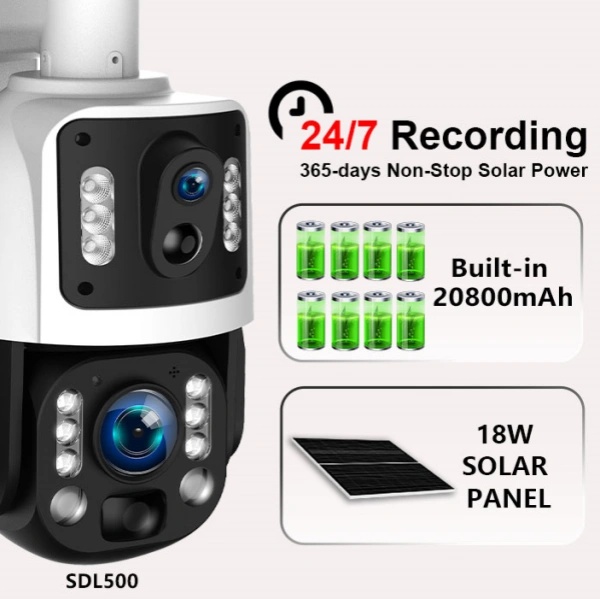Battery-Powered Security Cameras: Secrets to Ultra-Long Standby and Smart Power-Saving Tech
For distributors, installers, and brand owners, the promise of wire-free security is often undermined by a single, persistent pain point: battery life. Frequent trips to remote sites just to recharge a camera are not just an inconvenience; they are a direct hit to profitability and customer satisfaction. This “battery anxiety” is the number one obstacle to scaling deployments of battery-powered cameras. The critical question isn’t just about battery size, but about the intelligence that manages its power.
As an engineer with over a decade in designing these systems, I can confirm that the secret to ultra-long standby isn’t found in a bigger battery alone. It lies in a sophisticated ecosystem of low-power components, intelligent wake-up triggers, and optimized firmware. Understanding these technologies is crucial for providing your customers with a reliable, low-maintenance security solution that truly delivers on the wire-free promise. This is what separates a top-tier product from a device that causes endless support calls.
This article will deconstruct the core technologies that enable months of operation on a single charge. We will explore the critical role of PIR sensors, low-power SoCs, and smart power modes, offering a clear roadmap for selecting and deploying cameras that maximize both security and operational efficiency. For B2B partners, this knowledge translates directly into a stronger product offering and a more credible brand.
The Core Technology: How Smart Power-Saving Actually Works
A common misconception is that a battery-powered security camera is “on” 24/7, just like a traditional wired camera. This is fundamentally incorrect and the reason many low-quality cameras fail to meet battery life expectations. A true low-power camera spends over 99% of its time in a deep sleep or standby mode, consuming mere microamps of power.
The magic happens in the “wake-up” process. The entire system is built around a simple principle: only activate the main processor, image sensor, and communication module when absolutely necessary. This is achieved through a synergy of hardware and software components.
- Passive Infrared (PIR) Sensor: This is the frontline gatekeeper. A PIR sensor detects changes in infrared radiation—the body heat emitted by people and animals. It operates on extremely low power and is always active. When it detects a significant thermal signature within its range, it sends an electrical signal to wake up the camera’s main processor (SoC).
- Low-Power System-on-a-Chip (SoC): The “brain” of the camera is specifically chosen for its power efficiency. Modern SoCs have multiple power states. In deep sleep, they consume minimal energy. Upon receiving the wake-up signal from the PIR, the SoC boots up rapidly, activates the image sensor, starts recording, and initiates a network connection if needed.
- Efficient Firmware: The software running on the SoC is meticulously optimized. It ensures the wake-up and recording process is completed in milliseconds. After the event is over (e.g., the motion stops or the recording duration is met), the firmware promptly returns the camera to its deep-sleep state, preventing unnecessary power drain.
- Battery Management System (BMS): A sophisticated Battery Management System (BMS) is vital. It not only protects the battery from overcharging and over-discharging but also provides accurate power level readings and optimizes the power draw, extending the battery’s overall lifespan and reliability.
Power-Saving Modes Compared: A Technical Breakdown
Not all security scenarios are the same. A camera monitoring a quiet backyard has different power requirements than one at a busy warehouse entrance. That’s why high-quality battery cameras offer multiple power-saving modes. As a B2B partner, understanding these modes helps you guide your clients to the perfect setting for their needs.
| Mode | Primary Trigger | Typical Battery Life | Best Use Case |
|---|---|---|---|
| Ultimate Power-Saving Mode | PIR motion detection only. The camera is in deep sleep until woken by the PIR sensor. | 6-10 months | Low-traffic areas: vacation homes, sheds, back gates, areas with infrequent activity. |
| Performance Mode | PIR motion detection + remote live view access. The network module maintains a light connection for faster wake-up. | 2-4 months | High-priority areas requiring quick live-view access: front doors, driveways, small business entrances. |
| Custom / Adaptive Mode | User-defined settings for PIR sensitivity, recording duration, and sleep intervals. | Varies based on settings | For installers and advanced users who need to fine-tune the camera’s behavior for specific environments. |
Case Study: Securing a Remote Construction Site
Problem: A property developer needed to secure a new construction site located miles from the nearest power grid or Wi-Fi hotspot. Theft of materials and equipment was a major concern, but sending personnel to change batteries every few weeks was not a viable option. They required a “set-and-forget” solution.
Solution: We deployed UBOXCAM’s 4G battery-powered camera with a high-capacity 20,000mAh battery pack. The camera was configured to “Ultimate Power-Saving Mode” and the PIR sensitivity was adjusted to ignore small animals, focusing only on human and vehicle-sized objects. The 4G connectivity allowed for remote monitoring without any local network infrastructure.
Result: The camera operated autonomously for over 7 months on its initial charge, with an average of 5-8 motion triggers per day. The developer reported an 85% reduction in material theft after the first two months. The solution saved an estimated 40 man-hours in site visits for security checks and battery maintenance over the project’s first year, delivering a clear and rapid return on investment.
Troubleshooting Common Battery Drain Issues
When customers complain about rapid battery drain, the issue is rarely a faulty battery. From an engineering perspective, the cause is almost always environmental or settings-related. Here are the most common culprits and their solutions:
- Issue: Excessive False Triggers.
- Cause: The PIR sensor is aimed at a busy street, swaying trees, or near an HVAC exhaust vent.
- Solution: Reposition the camera to monitor only the desired area. Lower the PIR sensitivity in the app settings to reduce responsiveness to minor movements or temperature changes.
- Issue: Weak 4G or Wi-Fi Signal.
- Cause: The camera’s communication module has to work harder and use more power to maintain a stable connection in a low-signal area.
- Solution: If possible, move the camera to a location with a stronger signal. For 4G cameras, consider using a model with an external antenna for better reception.
- Issue: Extreme Cold Weather.
- Cause: Lithium-ion battery chemistry is less efficient at temperatures below freezing (0°C or 32°F). The battery’s effective capacity is temporarily reduced.
- Solution: Select a camera with a specified cold-weather operating range. When possible, install the camera in a location that receives some direct sunlight to keep it warmer during the day. For critical applications in frigid climates, pairing with a solar panel is highly recommended.
Market Trends and The Future of Low-Power Cameras
The technology behind battery-powered cameras is constantly evolving. The next generation of devices will push standby times even further and offer greater intelligence. As a business, staying ahead of these trends is key to a competitive product lineup.
AI on the Edge: The most significant trend is the integration of on-device AI. Instead of waking the camera for every PIR trigger, an ultra-low-power AI chip can analyze the motion to determine if it’s a person, vehicle, or animal. The camera only fully wakes and records for relevant events, drastically cutting down on false alarms and saving immense amounts of power. This is a core feature of what defines a modern low-power camera.
Perpetual Power with Solar: The synergy between battery cameras and high-efficiency solar panels is becoming the industry standard. Even a small solar panel can be enough to trickle-charge the battery during the day, effectively creating a perpetual power solution that eliminates battery anxiety entirely for most use cases.
A Practical Selection Guide for B2B Buyers
When sourcing battery-powered cameras for your portfolio, look beyond the megapixel count. Use this checklist to evaluate the power management technology, which is the true indicator of performance and reliability.
- ✅ Battery Capacity (mAh): Is the stated capacity genuine? Look for a minimum of 10,000mAh for decent standby. Verify supplier certifications.
- ✅ PIR Sensor Quality: Ask about the detection range and angle. A wider, more accurate sensor provides better coverage.
- ✅ Customizable Power Modes: Does the camera’s software allow for granular control over power-saving settings? A one-size-fits-all approach is inadequate.
- ✅ AI-Powered Filtering: Does the camera offer on-device human or vehicle detection? This is a key feature for reducing false alerts and conserving battery.
- ✅ Cold Weather Rating: Check the official operating temperature range. This is non-negotiable for deployments in northern climates.
- ✅ Solar Panel Compatibility: Does the manufacturer offer a compatible, high-efficiency solar panel as an accessory? This is a powerful upselling opportunity.
Key Takeaways for Your Business
Focusing on intelligent power management is how you win in the battery-powered security camera market. It allows you to sell solutions, not just products. By educating your clients on these features, you empower them to build more reliable and cost-effective security systems.
Here are the crucial points to remember:
- Standby is About Intelligence, Not Just Size: A smart battery-powered security camera uses a combination of PIR sensors and low-power SoCs to stay in deep sleep mode until a relevant event occurs.
- Configuration is Key: Educate your customers on how to use power-saving modes and adjust PIR sensitivity to match their environment. This prevents dissatisfaction and support requests.
- AI is a Game-Changer: On-device AI that filters out false alarms is the single biggest factor in extending real-world battery life. Prioritize models with this capability.
- Offer the Complete Solution: Pairing cameras with optional solar panels transforms a low-maintenance product into a zero-maintenance one, creating immense value for the end-user.
By partnering with a manufacturer like UBOXCAM that deeply understands these technical nuances, you can confidently provide your market with cutting-edge, reliable, and highly competitive security solutions. To discuss custom branding and feature integration for your next product line, contact our engineering team today.

